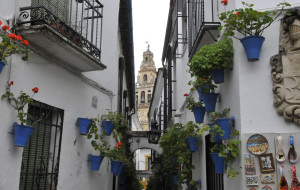After Muslims conquered Cordoba from the Visigoths in 711 A.D., they made it the capital of an Islamic state in southern Spain. By the tenth century, Cordoba was the largest and most important city in the world, with population estimates as high as one million. Cordoba’s Grand Mosque, completed in 987, accommodated 20,000 worshipers. With the rest of Europe dark, Cordoba featured lighted streets and illuminated minds. Students from around the world studied in its university. Averroes, born in Cordoba in 1126, made major contributions to medicine, astronomy, geography, mathematics and physics. His comments on the works of Aristotle contributed to the eventual rise of secular thought in Western Europe.
The Islamic conquest of southern Spain also ushered in a golden age for Spanish Jews, who had been persecuted by the Visigoths and other Christians. With support from Islamic rulers, Cordoba became a center of Jewish learning. Jewish writers translated ancient Greek works into Latin, setting the stage for the Renaissance. Moses Maimonides, the great Jewish philosopher and physician, began his studies in Cordoba, but was forced to leave Cordoba for Morocco in about 1160 after a strict Muslim sect from Africa conquered Cordoba and threatened Jews with death if they did not convert to Islam. Cordoba’s creativity soon died along with its tolerance.
Today, a statue of a seated Maimonides holding a book anchors Cordoba’s restored Jewish section. Whitewashed homes, with balconies overlooking narrow streets, are literally in the shadow of the Grand Mosque, now a cathedral. Cordoba’s only surviving synagogue, now a museum, encourages reflection on what Cordoba’s history can teach us all about the values of religious tolerance.

Comments are closed.